Prediction of Oil Palm Yield Using Machine Learning in the Perspective of Fluctuating Weather and Soil Moisture Conditions: Evaluation of a Generic Workflow
Abstract
1. Introduction
2. Materials and Methods
2.1. Study Site
2.2. Multi-Source Datasets
2.3. Prediction Framework
2.4. Data Pre-Processing
2.4.1. Integration
2.4.2. Data Cleaning
2.4.3. Data Reduction
2.4.4. Data Transformation
2.5. Model Development Process
2.5.1. Model Selection
2.5.2. Model Building
- Extra Tree Regressor: Theoretical background and its application in the prediction problem
- AdaBoost Regressor: Theoretical background and its application in prediction problem
2.5.3. Performance Evaluation and Comparison via Evaluation Matrices
3. Results
3.1. Model-Based Feature Importance
3.2. Evaluation of the Extra Tree and AdaBoost Regressors via Residuals, Prediction Error
3.3. Evaluation of Extra Tree and AdaBoost via Learning Curve and Validation Curve
3.4. Comparative Analysis of Selected Models with Tree-Based Regressors
3.5. Comparative Analysis of Selected Models with Conventional Regression Methods
4. Discussion
4.1. Interpretability of the Models
4.1.1. Feature Selection
4.1.2. Interpretation of the Models
4.1.3. Reusability of the Workflow
4.1.4. Limitations of the Workflow
5. Conclusions
Author Contributions
Funding
Data Availability Statement
Acknowledgments
Conflicts of Interest
References
- Van Klompenburg, T.; Kassahun, A.; Catal, C. Crop yield prediction using machine learning: A systematic literature review. Comput. Electron. Agric. 2020, 177, 105709. [Google Scholar] [CrossRef]
- Rashid, M.; Bari, B.S.; Yusup, Y.; Kamaruddin, M.A.; Khan, N. A Comprehensive Review of Crop Yield Prediction Using Machine Learning Approaches With Special Emphasis on Palm Oil Yield Prediction. IEEE Access 2021, 9, 63406–63439. [Google Scholar] [CrossRef]
- Phalan, B.; Green, R.E.; Dicks, L.V.; Dotta, G.; Feniuk, C.; Lamb, A.; Strassburg, B.B.; Williams, D.R.; Zu Ermgassen, E.K.; Balmford, A. How can higher-yield farming help to spare nature? Science 2016, 351, 450–451. [Google Scholar] [CrossRef] [PubMed]
- Basso, B.; Liu, L. Seasonal crop yield forecast: Methods, applications, and accuracies. Adv. Agron. 2019, 154, 201–255. [Google Scholar]
- Schauberger, B.; Jägermeyr, J.; Gornott, C. A systematic review of local to regional yield forecasting approaches and frequently used data resources. Eur. J. Agron. 2020, 120, 126153. [Google Scholar] [CrossRef]
- Bali, N.; Singla, A. Emerging Trends in Machine Learning to Predict Crop Yield and Study Its Influential Factors: A Survey. Arch. Comput. Methods Eng. 2022, 29, 95–112. [Google Scholar] [CrossRef]
- Iizumi, T.; Ramankutty, N. How do weather and climate influence cropping area and intensity? Glob. Food Secur. 2015, 4, 46–50. [Google Scholar] [CrossRef]
- Fischer, R. Definitions and determination of crop yield, yield gaps, and of rates of change. Field Crops Res. 2015, 182, 9–18. [Google Scholar] [CrossRef]
- Esposito, S.; Carputo, D.; Cardi, T.; Tripodi, P. Applications and trends of machine learning in genomics and phenomics for next-generation breeding. Plants 2019, 9, 34. [Google Scholar] [CrossRef]
- Li, B.; Lecourt, J.; Bishop, G. Advances in non-destructive early assessment of fruit ripeness towards defining optimal time of harvest and yield prediction—A review. Plants 2018, 7, 3. [Google Scholar] [CrossRef]
- Simkin, A.J. Genetic engineering for global food security: Photosynthesis and biofortification. Plants 2019, 8, 586. [Google Scholar] [CrossRef] [PubMed]
- Hacisalihoglu, G.; Armstrong, P.R. Flax and Sorghum: Multi-Element Contents and Nutritional Values within 210 Varieties and Potential Selection for Future Climates to Sustain Food Security. Plants 2022, 11, 451. [Google Scholar] [CrossRef] [PubMed]
- Sellami, M.H.; Pulvento, C.; Lavini, A. Agronomic practices and performances of quinoa under field conditions: A systematic review. Plants 2020, 10, 72. [Google Scholar] [CrossRef] [PubMed]
- Cooper, M.; Technow, F.; Messina, C.; Gho, C.; Totir, L.R. Use of crop growth models with whole-genome prediction: Application to a maize multienvironment trial. Crop Sci. 2016, 56, 2141–2156. [Google Scholar] [CrossRef]
- Jui, S.J.J.; Ahmed, A.M.; Bose, A.; Raj, N.; Sharma, E.; Soar, J.; Chowdhury, M.W.I. Spatiotemporal Hybrid Random Forest Model for Tea Yield Prediction Using Satellite-Derived Variables. Remote Sens. 2022, 14, 805. [Google Scholar] [CrossRef]
- Tiwari, P.; Shukla, P.K. A review on various features and techniques of crop yield prediction using geo-spatial data. Int. J. Organ. Collect. Intell. (IJOCI) 2019, 9, 37–50. [Google Scholar] [CrossRef]
- Siad, S.M.; Iacobellis, V.; Zdruli, P.; Gioia, A.; Stavi, I.; Hoogenboom, G. A review of coupled hydrologic and crop growth models. Agric. Water Manag. 2019, 224, 105746. [Google Scholar] [CrossRef]
- Kasampalis, D.A.; Alexandridis, T.K.; Deva, C.; Challinor, A.; Moshou, A.; Zalidis, G. Contribution of remote sensing on crop models: A review. J. Imaging 2018, 4, 52. [Google Scholar] [CrossRef]
- Weiss, M.; Jacob, F.; Duveiller, G. Remote sensing for agricultural applications: A meta-review. Remote Sens. Environ. 2020, 236, 111402. [Google Scholar] [CrossRef]
- Holloway, J.; Mengersen, K. Statistical machine learning methods and remote sensing for sustainable development goals: A review. Remote Sens. 2018, 10, 1365. [Google Scholar] [CrossRef]
- Shi, W.; Tao, F.; Zhang, Z. A review on statistical models for identifying climate contributions to crop yields. J. Geogr. Sci. 2013, 23, 567–576. [Google Scholar] [CrossRef]
- Chipanshi, A.; Zhang, Y.; Kouadio, L.; Newlands, N.; Davidson, A.; Hill, H.; Warren, R.; Qian, B.; Daneshfar, B.; Bedard, F. Evaluation of the Integrated Canadian Crop Yield Forecaster (ICCYF) model for in-season prediction of crop yield across the Canadian agricultural landscape. Agric. For. Meteorol. 2015, 206, 137–150. [Google Scholar] [CrossRef]
- Delavarpour, N.; Koparan, C.; Nowatzki, J.; Bajwa, S.; Sun, X. A Technical Study on UAV Characteristics for Precision Agriculture Applications and Associated Practical Challenges. Remote Sens. 2021, 13, 1204. [Google Scholar] [CrossRef]
- Hoefsloot, P.; Ines, A.V.; Dam, J.C.V.; Duveiller, G.; Kayitakire, F.; Hansen, J. Combining crop models and remote sensing for yield prediction: Concepts, applications and challenges for heterogeneous smallholder environments. In Proceedings of the Report of CCFAS-JRC Workshop at Joint Research Centre, Ispra, Italy, 13–14 June 2012. [Google Scholar]
- Charrier, G.; Ngao, J.; Saudreau, M.; Ameglio, T. Effects of environmental factors and management practices on microclimate, winter physiology, and frost resistance in trees. Front. Plant Sci. 2015, 6, 259. [Google Scholar] [CrossRef]
- Sharma, A.; Jain, A.; Gupta, P.; Chowdary, V. Machine learning applications for precision agriculture: A comprehensive review. IEEE Access 2020, 9, 4843–4873. [Google Scholar] [CrossRef]
- Narra, N.; Nevavuori, P.; Linna, P.; Lipping, T.; Dahanayake, A.; Huiskonen, J.; Kiyoki, Y.; Thalheim, B.; Jaakkola, H. A data driven approach to decision support in farming. In Information Modelling and Knowledge Bases XXXI; IOS Press: Amsterdam, The Netherlands, 2020; pp. 175–185. [Google Scholar]
- Xin, F.; Xiao, X.; Cabral, O.M.; White, P.M.; Guo, H.; Ma, J.; Li, B.; Zhao, B. Understanding the land surface phenology and gross primary production of sugarcane plantations by eddy flux measurements, MODIS images, and data-driven models. Remote Sens. 2020, 12, 2186. [Google Scholar] [CrossRef]
- Tantalaki, N.; Souravlas, S.; Roumeliotis, M. Data-driven decision making in precision agriculture: The rise of big data in agricultural systems. J. Agric. Food Inf. 2019, 20, 344–380. [Google Scholar] [CrossRef]
- Zamani Joharestani, M.; Cao, C.; Ni, X.; Bashir, B.; Talebiesfandarani, S. PM2. 5 prediction based on random forest, XGBoost, and deep learning using multisource remote sensing data. Atmosphere 2019, 10, 373. [Google Scholar] [CrossRef]
- Kelleher, J.D.; Mac Namee, B.; D’arcy, A. Fundamentals of Machine Learning for Predictive Data Analytics: Algorithms, Worked Examples, and Case Studies; MIT Press: Cambridge, MA, USA, 2020. [Google Scholar]
- Liu, J.; Goering, C.; Tian, L. A neural network for setting target corn yields. Trans. ASAE 2001, 44, 705. [Google Scholar]
- Pantazi, X.E.; Moshou, D.; Alexandridis, T.; Whetton, R.L.; Mouazen, A.M. Wheat yield prediction using machine learning and advanced sensing techniques. Comput. Electron. Agric. 2016, 121, 57–65. [Google Scholar] [CrossRef]
- Khaki, S.; Wang, L.; Archontoulis, S.V. A cnn-rnn framework for crop yield prediction. Front. Plant Sci. 2020, 10, 1750. [Google Scholar] [CrossRef] [PubMed]
- Khan, N.; Kamaruddin, M.A.; Sheikh, U.U.; Yusup, Y.; Bakht, M.P. Oil palm and machine learning: Reviewing one decade of ideas, innovations, applications, and gaps. Agriculture 2021, 11, 832. [Google Scholar] [CrossRef]
- Tilman, D.; Clark, M.; Williams, D.R.; Kimmel, K.; Polasky, S.; Packer, C. Future threats to biodiversity and pathways to their prevention. Nature 2017, 546, 73–81. [Google Scholar] [CrossRef] [PubMed]
- Chen, M.F. The impacts of perceived moral obligation and sustainability self-identity on sustainability development: A theory of planned behavior purchase intention model of sustainability-labeled coffee and the moderating effect of climate change skepticism. Bus. Strategy Environ. 2020, 29, 2404–2417. [Google Scholar] [CrossRef]
- Furumo, P.R.; Aide, T.M. Characterizing commercial oil palm expansion in Latin America: Land use change and trade. Environ. Res. Lett. 2017, 12, 024008. [Google Scholar] [CrossRef]
- Vijay, V.; Reid, C.D.; Finer, M.; Jenkins, C.N.; Pimm, S.L. Deforestation risks posed by oil palm expansion in the Peruvian Amazon. Environ. Res. Lett. 2018, 13, 114010. [Google Scholar] [CrossRef]
- Nantha, H.S.; Tisdell, C. The orangutan–oil palm conflict: Economic constraints and opportunities for conservation. Biodivers. Conserv. 2009, 18, 487–502. [Google Scholar] [CrossRef]
- Luke, S.H.; Advento, A.D.; Aryawan, A.A.K.; Adhy, D.N.; Ashton-Butt, A.; Barclay, H.; Dewi, J.P.; Drewer, J.; Dumbrell, A.J.; Eycott, A.E. Managing oil palm plantations more sustainably: Large-scale experiments within the Biodiversity and Ecosystem Function in Tropical Agriculture (BEFTA) Programme. Front. For. Glob. Chang. 2020, 2, 75. [Google Scholar] [CrossRef]
- Hoffmann, M.; Donough, C.; Cook, S.; Fisher, M.J.; Lim, C.; Lim, Y.; Cock, J.; Kam, S.P.; Mohanaraj, S.; Indrasuara, K. Yield gap analysis in oil palm: Framework development and application in commercial operations in Southeast Asia. Agric. Syst. 2017, 151, 12–19. [Google Scholar] [CrossRef]
- Rhebergen, T.; Fairhurst, T.; Whitbread, A.; Giller, K.E.; Zingore, S. Yield gap analysis and entry points for improving productivity on large oil palm plantations and smallholder farms in Ghana. Agric. Syst. 2018, 165, 14–25. [Google Scholar] [CrossRef]
- Beyer, R.; Rademacher, T. Species Richness and Carbon Footprints of Vegetable Oils: Can High Yields Outweigh Palm Oil’s Environmental Impact? Sustainability 2021, 13, 1813. [Google Scholar] [CrossRef]
- Wei, L.; John Martin, J.J.; Zhang, H.; Zhang, R.; Cao, H. Problems and Prospects of Improving Abiotic Stress Tolerance and Pathogen Resistance of Oil Palm. Plants 2021, 10, 2622. [Google Scholar] [CrossRef] [PubMed]
- Lokers, R.; Knapen, R.; Janssen, S.; van Randen, Y.; Jansen, J. Analysis of Big Data technologies for use in agro-environmental science. Environ. Model. Softw. 2016, 84, 494–504. [Google Scholar] [CrossRef]
- Chapman, R.; Cook, S.; Donough, C.; Lim, Y.L.; Ho, P.V.V.; Lo, K.W.; Oberthür, T. Using Bayesian networks to predict future yield functions with data from commercial oil palm plantations: A proof of concept analysis. Comput. Electron. Agric. 2018, 151, 338–348. [Google Scholar] [CrossRef]
- Kartika, N.D.; Astika, I.W.; Santosa, E. Oil palm yield forecasting based on weather variables using artificial neural network. Indones. J. Electr. Eng. Comput. Sci. 2016, 3, 626–633. [Google Scholar] [CrossRef]
- Oettli, P.; Behera, S.K.; Yamagata, T. Climate based predictability of oil palm tree yield in Malaysia. Sci. Rep. 2018, 8, 2271. [Google Scholar] [CrossRef]
- Mazumdar, M.; Lin, J.-Y.J.; Zhang, W.; Li, L.; Liu, M.; Dharmarajan, K.; Sanderson, M.; Isola, L.; Hu, L. Comparison of statistical and machine learning models for healthcare cost data: A simulation study motivated by Oncology Care Model (OCM) data. BMC Health Serv. Res. 2020, 20, 350. [Google Scholar] [CrossRef]
- Ryo, M.; Rillig, M.C. Statistically reinforced machine learning for nonlinear patterns and variable interactions. Ecosphere 2017, 8, e01976. [Google Scholar] [CrossRef]
- Hussain, J. Deep Learning Black Box Problem; Uppsala University: Uppsala, Sweden, 2019. [Google Scholar]
- He, X.; Zhao, K.; Chu, X. AutoML: A Survey of the State-of-the-Art. Knowl.-Based Syst. 2021, 212, 106622. [Google Scholar] [CrossRef]
- Othman, A.S.; Tukimat, N.N.A. Assessment of the Potential Occurrence of Dry Period in the Long Term for Pahang State, Malaysia. MATEC Web Conf. 2018, 150, 03004. [Google Scholar] [CrossRef][Green Version]
- Nurul Ashikin, A.; Nor Diana, M.I.; Siwar, C.; Alam, M.; Yasar, M. Community Preparation and Vulnerability Indices for Floods in Pahang State of Malaysia. Land 2021, 10, 198. [Google Scholar] [CrossRef]
- Sujaul, I.; Ismail, B.; Muhammad, B.G.; Mohd, E.T.; Sahibin, A. Assessment of land use and land cover changes in the Tasik Chini Catchment area, Pahang, Malaysia using the GIS. Adv. Environ. Biol. 2010, 4, 404–414. [Google Scholar]
- Hamdan, O.; Rahman, A.K.; Samsudin, M. Quantifying rate of deforestation and CO2 emission in Peninsular Malaysia using Palsar imageries. IOP Conf. Ser. Earth Environ. Sci. 2016, 37, 012028. [Google Scholar] [CrossRef]
- Lewis, S.L.; Wheeler, C.E.; Mitchard, E.T.; Koch, A. Regenerate natural forests to store carbon. Nature 2019, 568, 25–28. [Google Scholar] [CrossRef]
- Tang, K.H.D.; Al Qahtani, H.M. Sustainability of oil palm plantations in Malaysia. Environ. Dev. Sustain. 2020, 22, 4999–5023. [Google Scholar] [CrossRef]
- Kushairi, A.; Loh, S.K.; Azman, I.; Hishamuddin, E.; Ong-Abdullah, M.; Izuddin, Z.; Razmah, G.; Sundram, S.; Parveez, G.K.A. Oil palm economic performance in Malaysia and R&D progress in 2017. J. Oil Palm Res 2018, 30, 163–195. [Google Scholar]
- Nambiappan, B.; Ismail, A.; Hashim, N.; Ismail, N.; Nazrima, S.; Idris, N.A.N.; Omar, N.; Saleh, K.; Hassan, N.A.M.; Kushairi, A. Malaysia: 100 years of resilient palm oil economic performance. J. Oil Palm Res. 2018, 30, 13–25. [Google Scholar] [CrossRef]
- Chakravarty, S.; Demirhan, H.; Baser, F. Fuzzy regression functions with a noise cluster and the impact of outliers on mainstream machine learning methods in the regression setting. Appl. Soft Comput. 2020, 96, 106535. [Google Scholar] [CrossRef]
- Lu, C.-T.; Kou, Y.; Zhao, J.; Chen, L. Detecting and tracking regional outliers in meteorological data. Inf. Sci. 2007, 177, 1609–1632. [Google Scholar] [CrossRef]
- Cousineau, D.; Chartier, S. Outliers detection and treatment: A review. Int. J. Psychol. Res. 2010, 3, 58–67. [Google Scholar] [CrossRef]
- Khalid, S.; Khalil, T.; Nasreen, S. A survey of feature selection and feature extraction techniques in machine learning. In Proceedings of the 2014 Science and Information Conference, London, UK, 27–29 August 2014. [Google Scholar]
- Zhu, L. Selection of multi-level deep features via spearman rank correlation for synthetic aperture radar target recognition using decision fusion. IEEE Access 2020, 8, 133914–133927. [Google Scholar] [CrossRef]
- Naik, N.; Mohan, B.R. Optimal feature selection of technical indicator and stock prediction using machine learning technique. In ICETCE 2019: Emerging Technologies in Computer Engineering: Microservices in Big Data Analytics, Proceedings of the International Conference on Emerging Technologies in Computer Engineering, Jaipur, India, 1–2 February 2019; Springer: Singapore, 2019. [Google Scholar] [CrossRef]
- Cao, X.H.; Stojkovic, I.; Obradovic, Z. A robust data scaling algorithm to improve classification accuracies in biomedical data. BMC Bioinform. 2016, 17, 359. [Google Scholar] [CrossRef]
- Yadav, S.; Shukla, S. Analysis of k-fold cross-validation over hold-out validation on colossal datasets for quality classification. In Proceedings of the 2016 IEEE 6th International Conference on Advanced Computing (IACC), Bhimavaram, India, 27–28 February 2016. [Google Scholar] [CrossRef]
- Ding, J.; Tarokh, V.; Yang, Y. Model selection techniques: An overview. IEEE Signal Process. Mag. 2018, 35, 16–34. [Google Scholar] [CrossRef]
- Ali, M. PyCaret: An Open Source, Low-Code Machine Learning Library in Python; PyCaret Version. 2020. Available online: https://pycaret.readthedocs.io/en/latest/ (accessed on 1 June 2022).
- Geurts, P.; Ernst, D.; Wehenkel, L. Extremely randomized trees. Mach. Learn. 2006, 63, 3–42. [Google Scholar] [CrossRef]
- Zhang, P.-B.; Yang, Z.-X. A novel adaboost framework with robust threshold and structural optimization. IEEE Trans. Cybern. 2016, 48, 64–76. [Google Scholar] [CrossRef] [PubMed]
- Zhu, X.; Zhang, P.; Xie, M. A Joint Long Short-Term Memory and AdaBoost regression approach with application to remaining useful life estimation. Measurement 2021, 170, 108707. [Google Scholar] [CrossRef]
- Schapire, R.E. Explaining adaboost. In Empirical Inference; Springer: Berlin/Heidelberg, Germany, 2013; pp. 37–52. [Google Scholar] [CrossRef]
- Bauer, E.; Kohavi, R. An empirical comparison of voting classification algorithms: Bagging, boosting, and variants. Mach. Learn. 1999, 36, 105–139. [Google Scholar] [CrossRef]
- Kumar, G.K.; Rani, D.M.; Koppula, N.; Ashraf, S. Prediction of House Price Using Machine Learning Algorithms. In Proceedings of the 2021 5th International Conference on Trends in Electronics and Informatics (ICOEI), Tirunelveli, India, 3–5 June 2021. [Google Scholar]
- Moore, F.C.; Lobell, D.B. Adaptation potential of European agriculture in response to climate change. Nat. Clim. Chang. 2014, 4, 610–614. [Google Scholar] [CrossRef]
- Shahhosseini, M.; Martinez-Feria, R.A.; Hu, G.; Archontoulis, S.V. Maize yield and nitrate loss prediction with machine learning algorithms. Environ. Res. Lett. 2019, 14, 124026. [Google Scholar] [CrossRef]
- Vogeler, I.; Thomas, S.; van der Weerden, T. Effect of irrigation management on pasture yield and nitrogen losses. Agric. Water Manag. 2019, 216, 60–69. [Google Scholar] [CrossRef]
- Hasan, R.I.; Yusuf, S.M.; Alzubaidi, L. Review of the state of the art of deep learning for plant diseases: A broad analysis and discussion. Plants 2020, 9, 1302. [Google Scholar] [CrossRef] [PubMed]
- Caliman, J.-P.; Southworth, A. Effect of drought and haze on the performance of oil palm. In Proceedings of the IOPRI International Oil Palm Conference: Commodity of the Past, Today, and the Future, Bali, Indonesie, 23–25 September 1998. [Google Scholar]
- De Caro, F.; De Stefani, J.; Vaccaro, A.; Bontempi, G. DAFT-E: Feature-based Multivariate and Multi-step-ahead Wind Power Forecasting. IEEE Trans. Sustain. Energy 2021, 13, 1199–1209. [Google Scholar] [CrossRef]
- Hewage, P.; Trovati, M.; Pereira, E.; Behera, A. Deep learning-based effective fine-grained weather forecasting model. Pattern Anal. Appl. 2021, 24, 343–366. [Google Scholar] [CrossRef]
- Khaki, S.; Wang, L. Crop yield prediction using deep neural networks. Front. Plant Sci. 2019, 10, 621. [Google Scholar] [CrossRef]
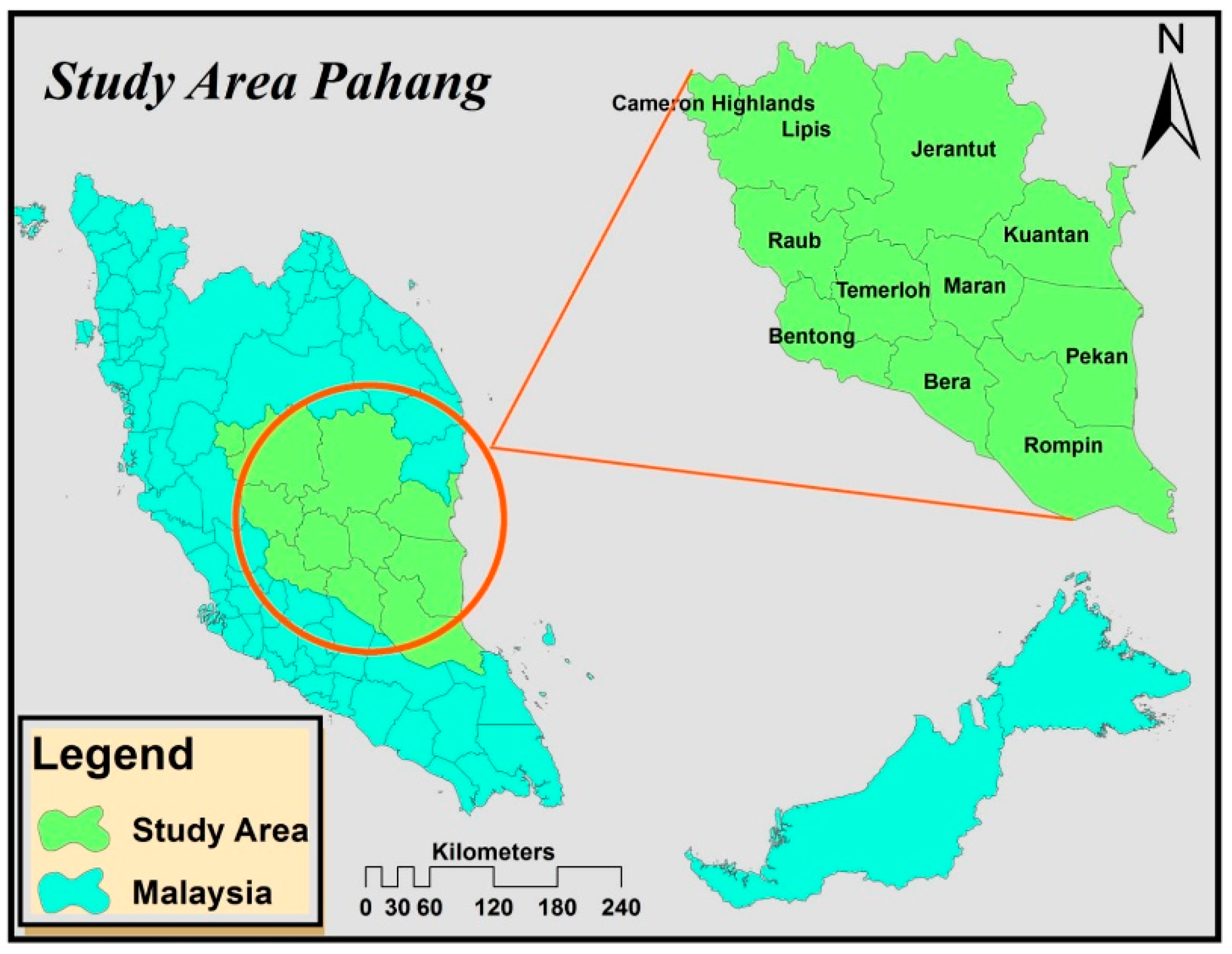


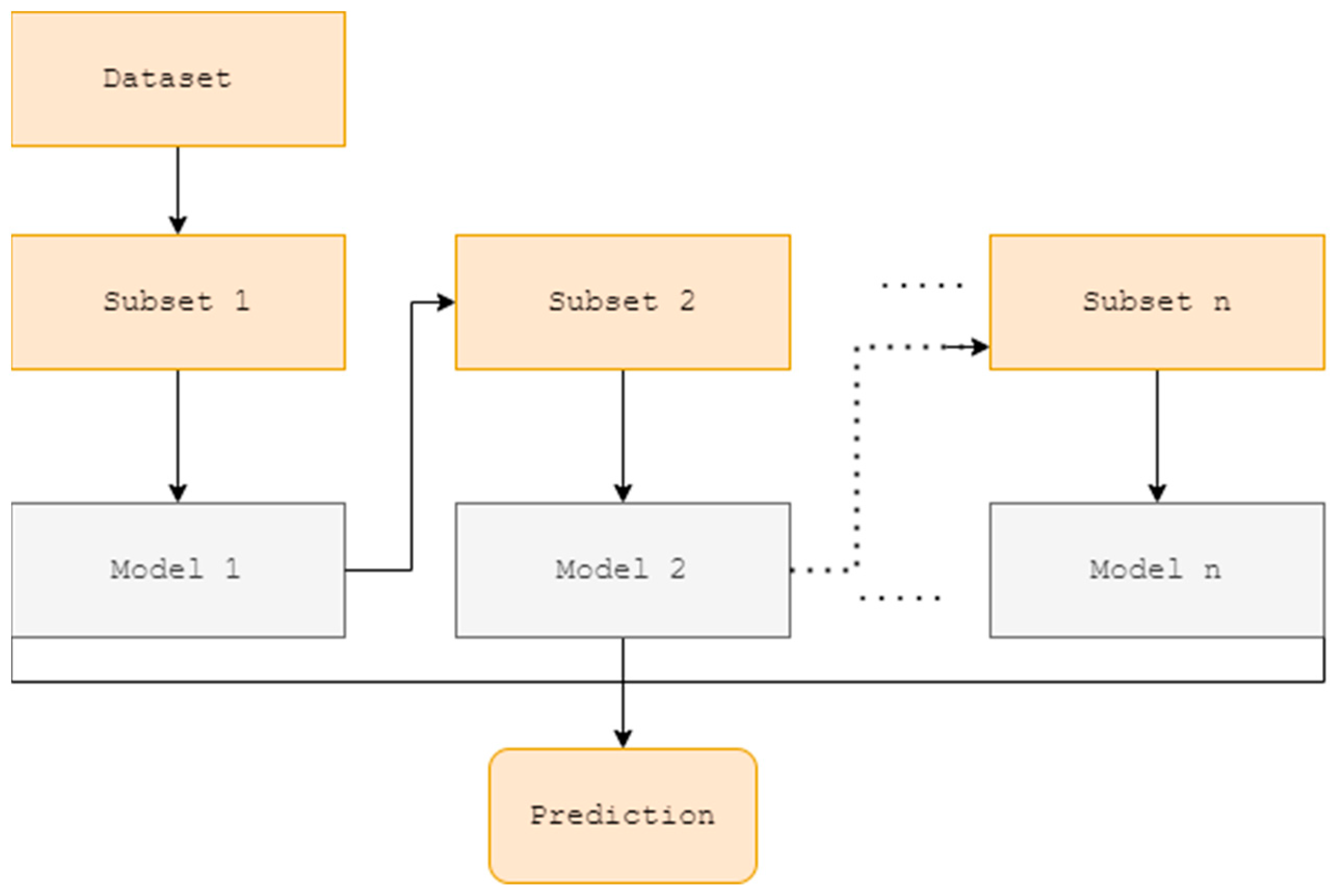


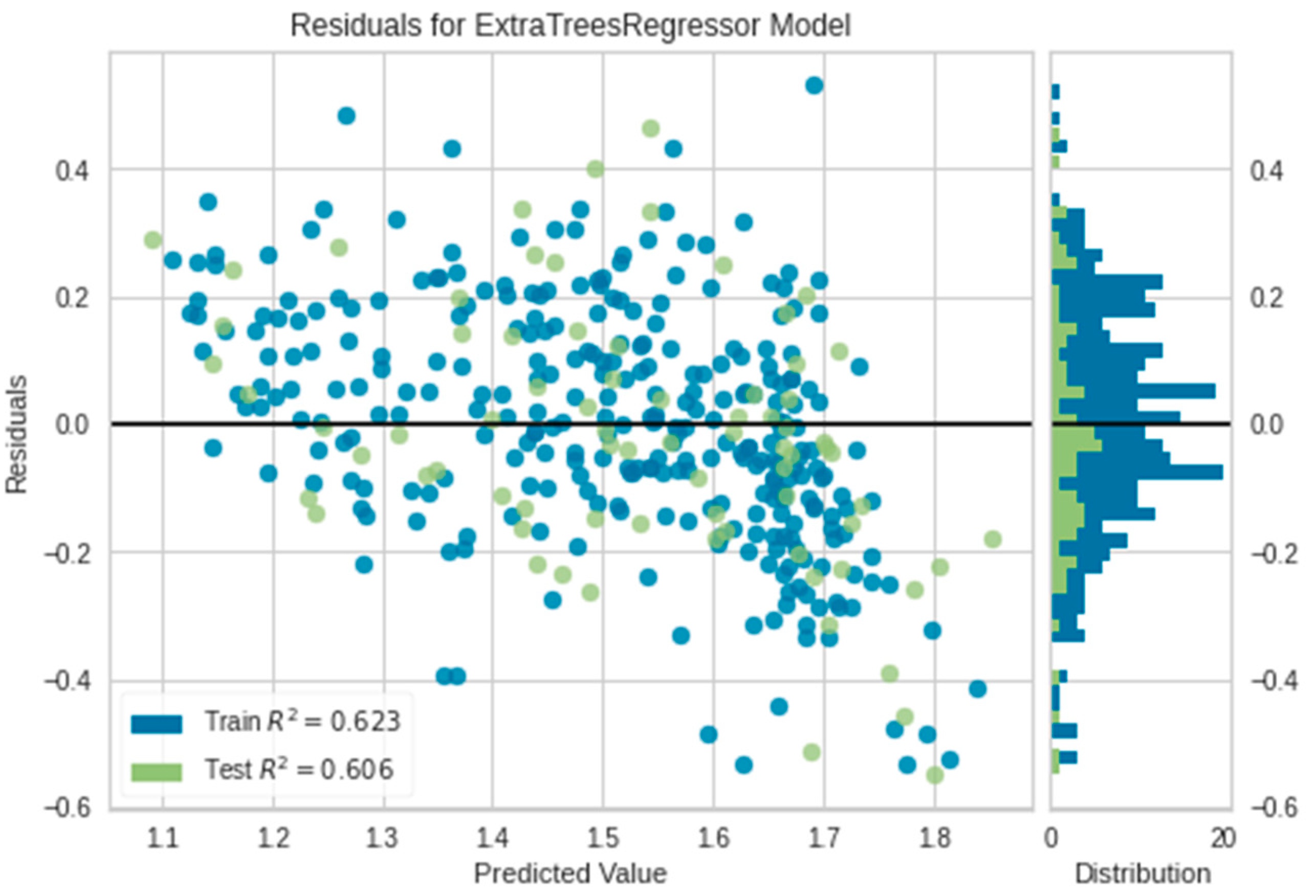



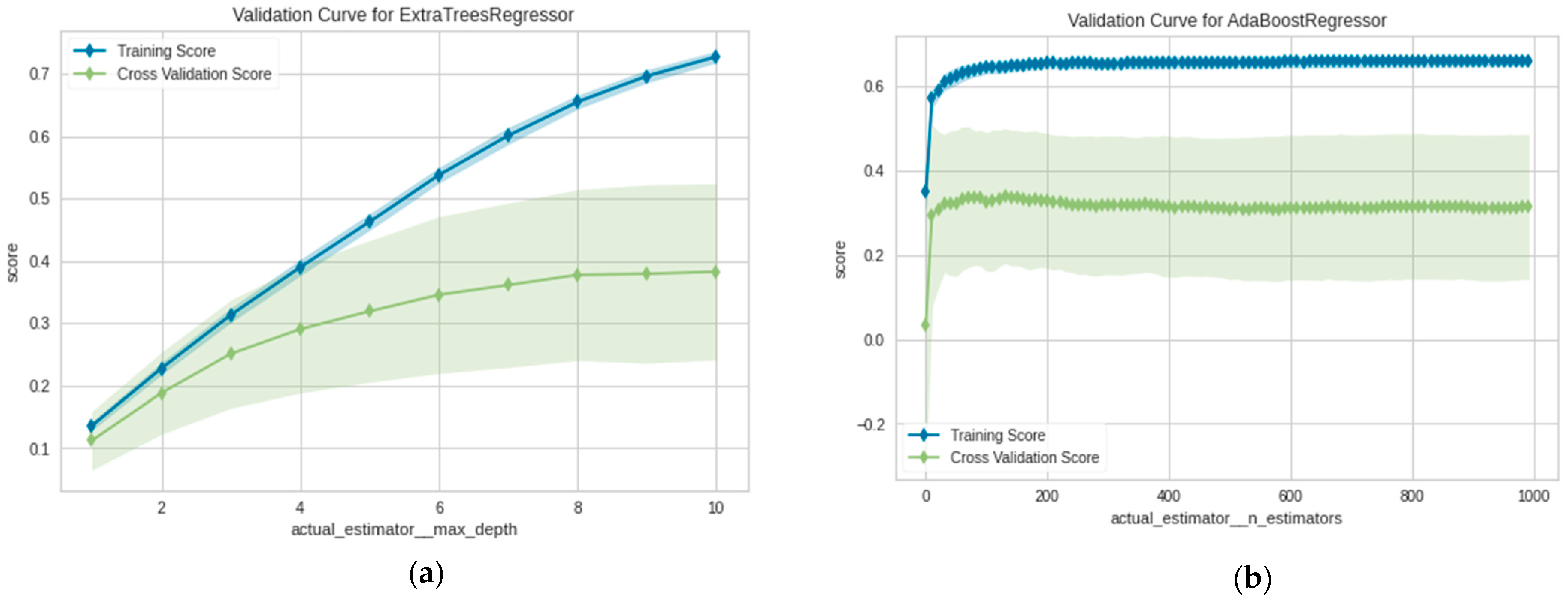

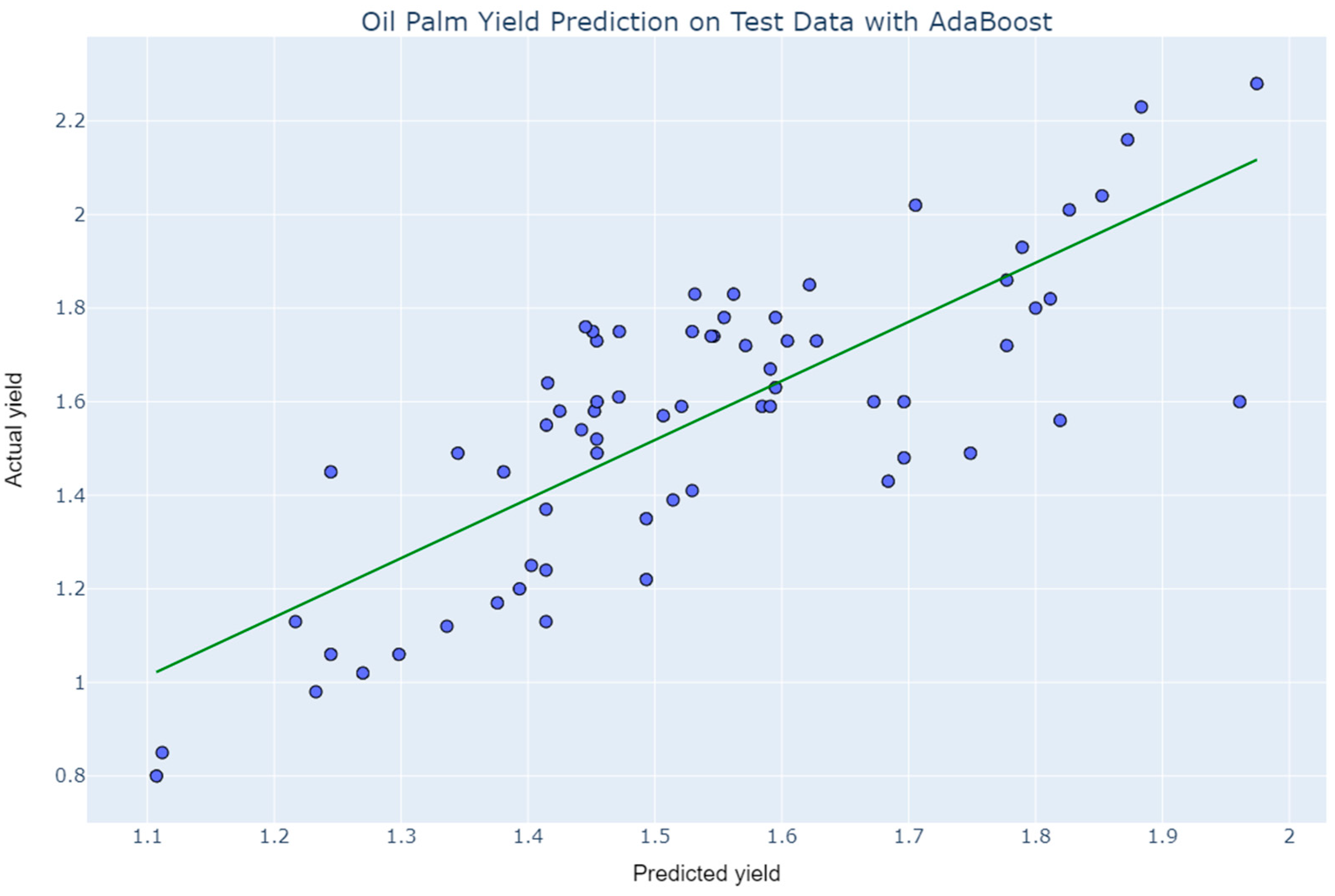

| Category | Variable | Spatial Resolution | Temporal Resolution | Time Coverage | Source |
|---|---|---|---|---|---|
| Crop data | Yield (t/h) | NA | 1 Month | 1986–2020 | MPOB |
| Soil moisture data | Surface soil wetness (%) | 10 m | 1 Month | 1986–2020 | NASA |
| Soil moisture data | Profile soil wetness (%) | 10 m | 1 Month | 1986–2020 | NASA |
| Soil moisture data | Root zone soil wetness (%) | 10 m | 1 Month | 1986–2020 | NASA |
| Meteorological data | Cloud amount (%) | NA | 1 Month | 1986–2020 | NASA |
| Meteorological data | Rain days/month | NA | 1 Month | 1986–2020 | MET |
| Meteorological data | Wind speed (m/s) | 10 m | 1 Month | 1986–2020 | NASA |
| Meteorological data | Rainfall (mm) | 10 m | 1 Month | 1986–2020 | MET |
| Meteorological data | Radiative flux (kW/h) | 2 m | 1 Month | 1986–2020 | NASA/MET |
| Meteorological data | Min temp (°C) | 2 m | 1 Month | 1986–2020 | NASA/MET |
| Meteorological data | Max temp (°C) | 2 m | 1 Month | 1986–2020 | NASA/MET |
| Meteorological data | Earth skin temp (°C) | 2 m | 1 Month | 1986–2020 | NASA/MET |
| Meteorological data | Temperature range (°C) | 2 m | 1 Month | 1986–2020 | NASA/MET |
| Meteorological data | Surface pressure (kpa) | 2 m | 1 Month | 1986–2020 | NASA/MET |
| Meteorological data | Relative humidity (%) | 2 m | 1 Month | 1986–2020 | NASA/MET |
| Meteorological data | Specific humidity (%) | 2 m | 1 Month | 1986–2020 | NASA/MET |
| Meteorological data | Precipitation (mm) | 2 m | 1 Month | 1986–2020 | NASA/MET |
| Model | MAE | MSE | RMSE | R2 | RMSLE | MAPE |
|---|---|---|---|---|---|---|
| Extra Tree | 0.1562 | 0.0405 | 0.2013 | 0.6057 | 0.0788 | 0.106 |
| AdaBoost | 0.1602 | 0.038 | 0.1951 | 0.63 | 0.0779 | 0.1073 |
| Random Forest | 0.1815 | 0.0534 | 0.2279 | 0.3894 | 0.0922 | 0.1289 |
| Decision Tree | 0.2505 | 0.1018 | 0.3161 | −0.2015 | 0.1273 | 0.1750 |
| Gradient Boosting | 0.1836 | 0.0545 | 0.2309 | 0.3748 | 0.0931 | 0.1301 |
Publisher’s Note: MDPI stays neutral with regard to jurisdictional claims in published maps and institutional affiliations. |
© 2022 by the authors. Licensee MDPI, Basel, Switzerland. This article is an open access article distributed under the terms and conditions of the Creative Commons Attribution (CC BY) license (https://creativecommons.org/licenses/by/4.0/).
Share and Cite
Khan, N.; Kamaruddin, M.A.; Ullah Sheikh, U.; Zawawi, M.H.; Yusup, Y.; Bakht, M.P.; Mohamed Noor, N. Prediction of Oil Palm Yield Using Machine Learning in the Perspective of Fluctuating Weather and Soil Moisture Conditions: Evaluation of a Generic Workflow. Plants 2022, 11, 1697. https://doi.org/10.3390/plants11131697
Khan N, Kamaruddin MA, Ullah Sheikh U, Zawawi MH, Yusup Y, Bakht MP, Mohamed Noor N. Prediction of Oil Palm Yield Using Machine Learning in the Perspective of Fluctuating Weather and Soil Moisture Conditions: Evaluation of a Generic Workflow. Plants. 2022; 11(13):1697. https://doi.org/10.3390/plants11131697
Chicago/Turabian StyleKhan, Nuzhat, Mohamad Anuar Kamaruddin, Usman Ullah Sheikh, Mohd Hafiz Zawawi, Yusri Yusup, Muhammed Paend Bakht, and Norazian Mohamed Noor. 2022. "Prediction of Oil Palm Yield Using Machine Learning in the Perspective of Fluctuating Weather and Soil Moisture Conditions: Evaluation of a Generic Workflow" Plants 11, no. 13: 1697. https://doi.org/10.3390/plants11131697
APA StyleKhan, N., Kamaruddin, M. A., Ullah Sheikh, U., Zawawi, M. H., Yusup, Y., Bakht, M. P., & Mohamed Noor, N. (2022). Prediction of Oil Palm Yield Using Machine Learning in the Perspective of Fluctuating Weather and Soil Moisture Conditions: Evaluation of a Generic Workflow. Plants, 11(13), 1697. https://doi.org/10.3390/plants11131697









